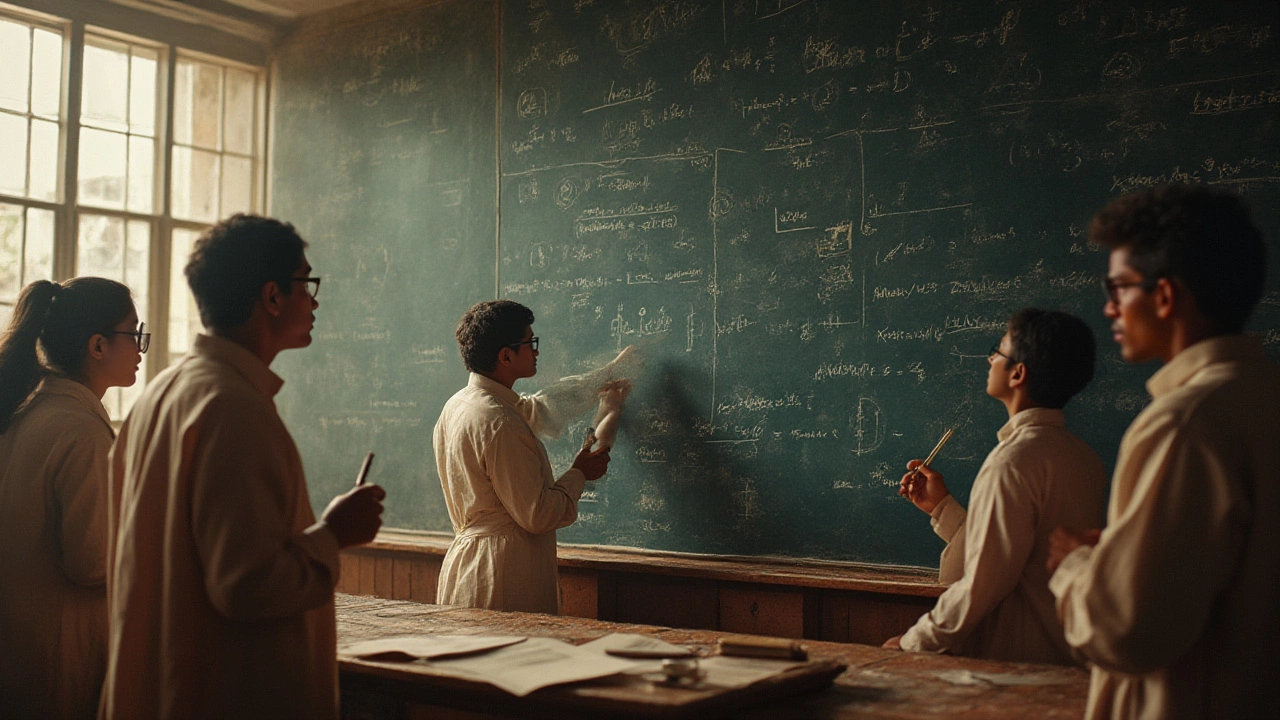Picture this: a cool breeze coming from an open window, maybe a coffee in hand, you’re staring at a math problem—for hours. Your brain’s fully cranked, but the answer just sits out of reach, taunting you. That’s the daily reality for mathematicians wrestling with the world’s hardest math. Forget what you wrangled with in high school—the harshest math puzzles on earth don’t just “challenge” people, they genuinely break the best minds in the business. Why do these tough problems matter? Because sometimes, answering one question unlocks entire new fields, and at other times, a stubborn theorem holds up real-world progress for decades. Math, at its roughest, is much more than numbers on a page; it's a story packed with legend, fame, obsession, even a touch of madness.
The Legendary Giants: Math’s Most Impossible Puzzles
What makes math impossibly hard? It’s rarely some mind-bending calculation; the real challenge shows up when the solution seems light-years away, no matter how you approach it. Take the famous Millennium Prize Problems. Back in 2000, the Clay Mathematics Institute picked seven problems so tough, they slapped a million-dollar reward on each. Solve one, and you’re a math superstar. As of July 2025, only one—Poincaré Conjecture—has been tamed. The rest? They STILL sit, like uncrackable safes, waiting for someone to find the right key.
The reigning champion of hard math is probably the Riemann Hypothesis. Proposed in 1859, it stares back at mathematicians from the edge of the unknown. Basically, it deals with how prime numbers—those indivisible building blocks of numbers—line up on the number line. Why does it matter? Prime numbers turn up everywhere in our lives, from internet security to random number generators. The Riemann Hypothesis predicts a pattern in how primes are spaced—but nobody’s actually proved it yet. Hundreds of mathematicians tried. A solution could flip parts of modern computer security on its head.
Another giant: the Navier-Stokes Existence and Smoothness problem. Sounds technical, but it’s at the heart of how fluids work. Planes, oceans, the weather, your coffee swirling in a mug—all run on fluid dynamics. The Navier-Stokes equations, which are 200 years old, describe how these fluids move. The catch? No one can prove, with mathematical certainty, that these equations work in every situation. We can simulate them fine for airplanes and car design, but on paper, there are question marks so big they've stumped everyone for generations.
Curious about how wild math puzzles can get? It’s not just about equations or neat diagrams. Hodge Conjecture? That’s about figuring out which shapes can be carved out, using algebra, from smooth, curved spaces that twist around in ways we barely comprehend. The Birch and Swinnerton-Dyer Conjecture? It’s all about which equations have whole-number solutions, and ties deeply to stuff like cryptography and computer coding. Nobody's closed the case on either problem.
Let’s talk about Fermat’s Last Theorem for a second. It was considered hopeless for over 350 years. In 1994, British mathematician Andrew Wiles cracked it, after spending nearly a decade in solitary pursuit. It’s proof that what seems impossible today might actually just need the right mind, the right moment—and sheer determination.
Here’s a taste of just how persistent these tricky math monsters are:
| Problem | Year Proposed | Solved? | Prize Value |
|---|---|---|---|
| Riemann Hypothesis | 1859 | No | $1,000,000 |
| Navier-Stokes | 1845 | No | $1,000,000 |
| Hodge Conjecture | 1950 | No | $1,000,000 |
| Poincaré Conjecture | 1904 | Yes (2003) | $1,000,000 (refused) |
Here’s a weird fact: Grigori Perelman, the Russian genius who solved the Poincaré Conjecture in 2003, refused both the million-dollar prize and the Fields Medal (the math world’s answer to the Nobel). He said recognition wasn’t what drove him—he just wanted the story of the proof to be “understood.” That’s the mystical side of hard math, where obsession and beauty matter more than the money or trophies.
Plenty of tough math lies outside the famous seven, too. Take Collatz Conjecture—if you’ve never heard of it, imagine a game: take any number, and if it’s even, halve it; if it’s odd, triple it and add one. Repeat forever. Nobody’s proved this simple little game always lands on 1. It’s been tested for quintillions of numbers, but a formal proof? Zero luck. This question is so sticky, mathematicians warn students away: “Don’t waste your life on Collatz.” That’s a badge of true difficulty.

Why Hard Math Matters: Real-World Impact and Brain-Boosting Mystique
If you’re wondering whether these strange, super-difficult math puzzles actually matter, you’re not alone. Here’s the twist: sometimes, solving a single math problem flips our whole world upside down. Just look at prime numbers again. Without understanding them, our online banking wouldn’t be half as safe. Primes drive encryption—the way your data stays locked and private when you bank online, chat, or even stream videos. The whole world runs, quietly, on the back of problems like the Riemann Hypothesis. If someone cracks it, the math community will cheer, and technology companies may panic—because the way we keep digital secrets safe could need a total rethink.
Then there’s pure science. The Navier-Stokes equations aren’t just theoretical scribbles. They’re used to design safer airplanes, build more efficient cars, and predict the next big storm. Still, the biggest brains alive can’t guarantee they always work for wild, crazy fluids like whipped cream, turbulent smoke, or tornados. If we could finally pin those equations down completely, everything from weather forecasting to understanding the insides of stars would take a giant leap forward. Ever noticed the wild swings in climate models? Better math on these problems means more accurate predictions, which could save lives and billions of dollars.
Tough math doesn’t just whisper from university chalkboards. It powers entire industries. Internet security? Check. Weather forecasts? Absolutely. Hidden Markov Models—used in speech recognition and even bioinformatics—are rooted in tough probability problems. Machine learning and artificial intelligence eat through mountains of advanced math with each new breakthrough. Even Google Search uses linear algebra and graph theory that springs from these mysterious, high-level puzzles.
But here’s the kicker: sometimes, the biggest value is what the chase itself does to our brains. Wrestling with a tough puzzle, whether or not you solve it, makes your mind sharper and better at handling confusion. It’s like an extreme workout, only the muscle is your thinking power. That brain-boosting effect isn’t just for professional mathematicians. Anyone trying to figure out a fiercely tricky Sudoku or masterpiece puzzle gets a taste of that same rush—only the stakes are lower and your coffee less likely to get cold from all-night obsession.
Even failed attacks on math’s hardest puzzles lead to new discoveries. Time and again, pieces from one dead-end idea get recycled into a future breakthrough. The side paths often lead to strange new territories, fresh theorems, and even new entire branches of math. Who’d have guessed that trying (and failing) to solve Fermat’s Last Theorem would push people to invent algebraic number theory, which now underpins huge swaths of modern tech?
If you want a crazy story, look at Andrew Wiles, who cracked that ancient Fermat puzzle after more than seven years work alone in his attic. He said, “You enter a dark mansion, wander from room to room, bumping into furniture, until suddenly, two pieces click into place and you see how the rooms connect.” That kind of relentless persistence is almost its own reward. And it isn’t just math—every discipline, from physics to coding, leans on these brain-busting challenges to move forward.

Tips for Tackling Hard Math: Facing Goliaths Without Losing Your Mind
Okay, say you’re not a Harvard PhD—just an ordinary person who’s curious (or maybe a bit stubborn). Can you dip your toes into “hard math” without drowning? Actually, yes. Some of the world’s hardest puzzles have versions anyone can try. Here’s how to survive (and even enjoy) the journey:
- Start Small: Play with puzzle versions of unsolved problems. Try the Collatz Conjecture with your own numbers, or look up fun twists on Goldbach’s Conjecture. These tiny bites offer the flavor of deep math without the burn.
- Collaborate: The myth of the “lone genius” is just that—a myth. Even top researchers rely on daily chats, study groups, and Internet communities. Join discussion forums like Stack Exchange, drop into math Discord servers, or gather like-minded friends offline.
- Ask “Why?” Not Just “How?”: The difference between just solving exercises and really getting hard math is curiosity about why patterns hold. If a simple proof stumps you, that’s your chance to slow down and build intuition. Read blogs, seek out YouTube explainers by mathematicians, or follow threads on Reddit’s r/math.
- Get Visual: Even the toughest problems often have a hidden visual simplicity. Drawing pictures, mapping graphs, even fiddling with physical tools like dice or coins can snap abstract ideas into focus. Break out the whiteboard, doodle, don’t be afraid to make it look silly.
- Pace Yourself: Math breakthroughs can take months, even years. Take breaks, switch goals, and let your mind unfocus every now and then. Sometimes, the best “aha” moments come while you’re walking the dog or making toast.
Pro tip? Model your strategy on mathematicians like Terence Tao (sometimes called the Mozart of Math) who embraces failure as part of the job. “You have to be willing to play with the math, take it apart, and see what breaks.” With that attitude, hard math becomes less a scary monster, more an ongoing adventure story.
A fun experiment? Grab any tough-looking theorem and see if you can explain it to a friend or middle-schooler. If you can, you’ve really won. If not, you’ll spot the gaps in your own understanding—an expert trick the professionals swear by. And always, always remember: even the hardest math problems began as someone’s simple question. Who knows—maybe the next person to make headlines is someone just as baffled, stubborn, and obsessed as you.
